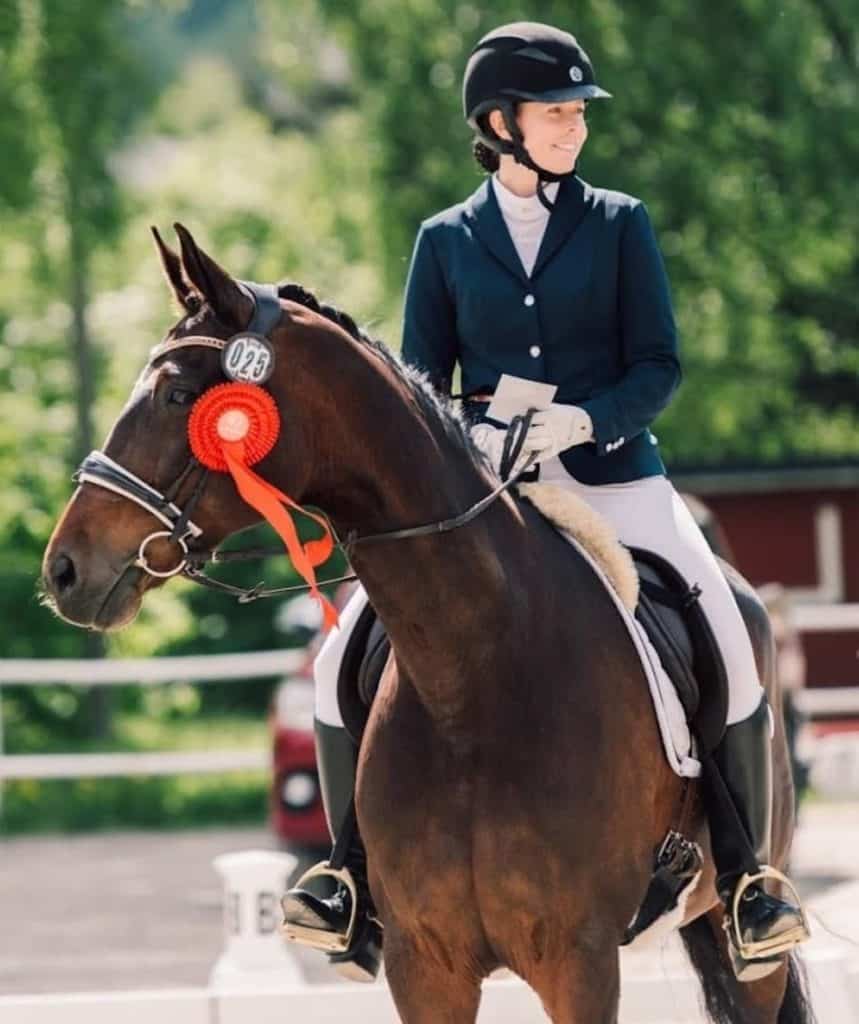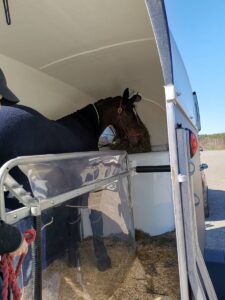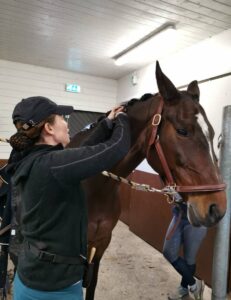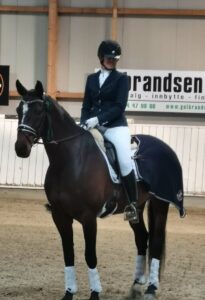
So, you have been training and working with your horse, and now it feels like it is time. Time to compete at your first horse show. We all dream of having our best day in the arena and having the colorful ribbon or trophy handed to us at the end of the day, but the way there might be a little more blurred.
Going to horse shows and competing can be a big motivational driver for continued training but should also be a positive experience for both yourself and your horse.
Poor preparations can often exacerbate stress and nerves on show day and usually results in an anxious horse and ultimately a less than optimal performance. This is why planning ahead is so important. It gives you peace of mind and helps you feel relaxed and in control, which in turn helps your horse feel comfortable as well.
In the following, we will cover the things you need to think about before heading off to your first competition. As I primarily ride dressage, that will be the focus of this article, but you can easily adapt these tips to your own discipline.
Grab Your Own Horse Show Preparation Checklist!
Early Preparations
Some preparations need to be made several weeks and sometimes months in advance. Certain tasks on this list you may only need to do once (or once per year) and some may not even be relevant for you so you can check them off right away (isn’t it a great feeling when you can check something off your to-do list without even lifting a finger?!).
Choosing a Show
Depending on the accessibility, choose the show you want to attend a few months before the competition. Some of the considerations for choosing a horse show can be; what level do you wish to compete at? How far away is the show? How are the facilities for parking, warmup and competition arena? How much is it going to cost?
As a first-time competitor I would recommend choosing a horse show as close to home as possible if neither you nor your horse are used to travelling. Less travel means a shorter day for the both of you.
Choosing a Test or Program
Next up is choosing what test to ride and what program to register for. Experienced riders might start two programs in one day, but for newbies, it might be enough to concentrate on just one program.
If it’s your first time, opt for a program you know both you and the horse can do well and don’t be tempted to ‘reach for the stars’. Even if you feel that you can manage a higher level at home, in the competition arena it is likely that neither horse nor rider will perform as well due to a range of factors such as the unfamiliar environment and nerves.
Give both of you a good first show experience by not expecting too much, and rather focus on familiar exercises and movements. As a novice rider it might be good to feel well prepared and confident rather than daunted by the challenge.
Training Before the Competition
Memorize and start rehearsing the program with your horse. Make sure you memorize the program according to the letters and not the pattern the movements make as I have seen this confuse inexperienced riders when the show arena is orientated differently than what they are used to.
It is usually best to work on the different exercises and parts of the program, but not to ride the whole thing through, again and again, every day. Horses are clever, and you don’t want the horse to know the program too well. He might beat you to it and pre-empt movements on the show day, which will affect the accuracy of your riding and lose you points.
If your arena doesn’t have letters, make some and hang them. Precise riding is important and can win (or lose) you many points. Also, if your arena is not 20 * 40 meters (or 60 if you are riding at higher levels ), try to measure this out so you can practice on a similar surface area to what you will have at the show.
Have a friend or your trainer watch you ride and give feedback. Asking someone to film you when you ride through the program is also gold so you can watch it and make mental notes about what you would still like to work on. It will also help you and build confidence as you see yourself improving.
Preparing for Travel with Your Horse

Is your horse used to traveling? Are you? Stress-free loading, off-loading and driving is key to a making your show experience a happy one.
Pull out the trailer and practice loading and off-loading until you both are comfortable with the process. Put on any blankets and leg protection you are planning to use so the horse can get accustomed to this as well.
Take the horse and trailer for a short 5-10 minute drive to get him used to standing up while in motion. Drive slowly and carefully – remember your partner is trying to balance in the back!
Get Your Paperwork in Order
Unfortunately, there is some paperwork involved when going to a horse show. Rules and regulations vary between countries and states, but if you have any questions, ask other competitive riders with experience or contact the riding club or show organizer for guidance.
These are a few examples of paperwork you might need:
- riders license
- horse license
- up to date vaccination card
- driver’s license for horse trailer
- proof that horse trailer is up to code and approved for animal transport
- insurance certificate(s)
If you are in the US, you may want to check out the United States Dressage Federation (USDF) membership and horse registration requirements.
Recruit a Helper or Assistant
It is fully possible to go to competitions alone, but for a first-timer, I would highly recommend having a person to help you. Preferably this person knows a little bit about horses and if you can bring someone who has experience from competitions you will gain so much from their experience.
However, no matter the background, having another person there with you will make the day that much smoother and fun!
One Week Out
The big day is now only one week away and you need to start thinking about some logistical preparations.
Checking Your Gear and Outfit
About a week before the show it’s time to go over your equipment and clothing. Does everything fit? Are the white breeches white? Do they need a wash? Is your jacket creased and in need of a round of ironing? Are you going to change at the show venue or will you wear something over the competition clothes to protect them from getting dirty? What shoes will you wear? What if it rains? Thinking through these things in advance and having a plan will help you
Did you buy something new and pretty that you’ve never worn? Try it on and try riding in it. You don’t want any surprises on the day of the show, such as new boots giving you blisters or your underwear chafing in inconvenient places.
Have a look through the rules and regulations for show equipment and attire. Is everything up to code? Be particularly careful with bits, rains, spurs and whips as rules vary and can be extremely specific.
To save yourself from having to figure it out on the day, perhaps also think through what you will do about hair and makeup for the competition. Remember that your hair will need to look neat and fit easily under the helmet.
Planning Your Travel
Plan your drive so that you have time for stops if you need them. I always check the route on Google maps to plan for detours if the shortest route turns out not to be the smoothest (I like to avoid steep hills and lots of turns if possible). If you are driving for many hours, make sure you stop to check on your horse, the temperature in the trailer, and offer him water underway.
Make sure the trailer is ready and clean. Check tire pressure and make sure all lights are working. Add new sawdust and hang a slow feeder hay net to keep the horse busy during the drive. If you don’t have one already, this is a durable slow hay feeder from Horze that we like.
The Day Before the Competition
It’s almost time and you are making final preparations for the big day ahead. You may be feeling those butterflies in your stomach now, which is completely normal. Even seasoned professional riders get nervous!
Preparing the Horse and Equipment
The day before the show you might want to give your horse a bath (or at least a very thorough grooming). Consider putting a blanket on him overnight so you don’t arrive in the morning to a horse that is covered in his own poop stains!
Polish you boots and brush off your helmet. Pack everything, for both you and your horse. Put most of it in the trailer and car, so that you don’t need to worry about forgetting anything the next day. Checklists are good to have! It’s easily done to forget something crucial like your bridle or helmet.
To help you avoid that kind of nightmare scenario, we have created a Horse Show Checklist that you can download here for free.
Check your scheduled starting time before going to bed and make a little itinerary (even if it’s just in your head) working backward from that time.
For instance, if your allotted start time is 3 pm you should arrive at the venue by 1 pm, which means you have to leave drive from the stable at 11.30 am, leave from home at 11 am, and so on. This will help you stay on track on the big day and know if you need to speed things up or if you have time to have a little cuddle time with your horse (we actually recommend scheduling this in!)
The Day of the Competition
It’s here! Time to reap the benefits of all that planning and have a smooth and fun day with your horse.
Getting Ready at the Barn

On the big day, you can hopefully focus just on the brushing, plaiting, and loading your horse onto the trailer. If your horse is a bit on the feisty side and known to kick out at other horses it is customary to tie a small red ribbon at the top of his tail as a gentle warning to other contestants.
Check your start time again first thing in the morning as changes may have occurred overnight.
Plan for a slow drive – you can’t, nor should you try to, drive as fast as a normal car with a horse trailer in tow.
At the Competition Venue
Park the trailer in a convenient location with level ground and in the shade if possible (if it’s hot). Open windows and hatches for air flow – a trailer can get very warm when standing still! Say hello to your horse and make sure he is calm and comfortable.
Registration and Getting Comfortable
Head over to the registration office to let them know that you have arrived. Pay your fees and ask any questions you might have. Usually you will need to present your horses’ ID and vaccination card for inspection as well as other mandatory paperwork for your area. After the registration is in order, take some time to familiarize yourself with the area if it is your first time there. Locate the arena, the warmup area, and the toilets.
What you do next depends on what is right for you and your horse. Some horses are spookier than others and will benefit from being led around the grounds on a lead rope to familiarise themselves with the surroundings. Others are not that bothered and are happy munching away at the hay net while the competition buzzes around them. Still, a short walk to stretch his legs after the drive is generally a good idea.
Tacking Up
For most one day shows you will need to tack up by your trailer. If you brought an assistant with you, this is a perfect task to share, but it is also possible to do it alone of course – it just takes a little planning and practice! If your horse is calm and fine with being tied up to the outside of the trailer, you can tie him up with a quick-release knot and tack him up.

However, not all horses will be calm enough to do this and if there is no designated area for tacking up at the venue, your last resort is then getting ready while the horse is still in the trailer. This can be rather cumbersome, but here as some pointers for doing so as smoothly as possible.
To tack up in the trailer, shift the partition as far to the right as possible (the horse should usually be standing on the left side if you are from a country that drives on the right side of the road), which means you will need to release the butt bar. Keep the ramp closed in case your horse tries to move backward. This will also limit the distractions and potential for him being spooked.
Groom and tack up the horse as much as possible on the trailer and prepare anything else you need outside before opening the ramp to offload the horse.
Warming Up
Give yourself time for a good warm-up, but don’t overdo it. You want the horse to be warm and supple, but not tired and sweaty.
The warm-up arena can be an intimidating place. It’s easy to be caught up by all the other riders, and not getting anything done. It may also seem like you will be ridden down at any moment. But, there are rules to guide all the madness.
The guidelines for a harmonious warmup may vary from country to country (also in regards to equipment) but the basics are:
- Always announce that you intend to enter the warm-up area. This is especially important if the arena is indoors with a restricted view to the entrance.
- The warm-up area is for working the horse. Walking with long rains talking to your friend on the phone should be done elsewhere.
- The warm-up ring is for horses and riders. Instructors, helpers, and others must stay outside the fence.
- Lunging is generally not permitted in the warm-up area. If you plan to lunge, ask the organizers if there is a dedicated space for this purpose when you register or even call ahead to check.
- You should always pass other riders on the left hand – left shoulder to left shoulder.
- Walk on an inside track, allowing those in faster gaits to pass you on the track.
- Don’t halt on the track. Halts should be made away from the track and the center- or diagonal lines. Avoid making sudden downward transitions if you have riders behind you.
- Allow for 1 horse length between you and other riders.
- Be courteous and if you get into an awkward situation or a near collision, a smile and an apology will usually go a long way.
You’re Up!
Do not be late! If you are not by the arena entrance when it’s your turn, you will be disqualified. If you have a helper, ask her to keep track of the time and alert you when it’s time to leave the warmup area to go to the show arena. That way you can focus fully on the riding.
When You’re Done
After you finish, take your horse for a little walk, and remember to offer him water. Many horses do not drink as much as they should at shows. Try to add some mash, apples, or carrots in the water to tempt your horse to drink.
What you do now usually depends on how many riders are in your group and how long you must wait for the results. Keep yourself updated so you can work out if you are likely to receive a prize or not.

If you are, you should get back on your horse to attend the award ceremony (it is usually possible to go without your horse as well, but what’s the fun in that?). This should be a proud moment where you are rewarded for the hard work you and your horse have put in, but remember to be polite and congratulate the other winners and don’t pass anyone who placed higher than you during the lap of honor.
After your level is finished you can collect your score sheet, usually from the office where you registered. If you have the opportunity, stop by the refreshments stand and make a purchase. Food sales are often the main source of income for the show organizer as this is a nice way to contribute to a local club putting on a competition.
Before Leaving
Before you leave, be sure to tidy up after yourself in the parking lot. Horse manure should be picked up and deposited in designated areas. Any tools or equipment borrowed must be returned and be sure to pay any fees owed. Remember that the people working at local shows are often volunteers, so make sure to treat them nicely.
Positive Attitude and Perspective
Going to a show or competition should be a nice experience for both you and your horse. It is an opportunity to test your skills under pressure and in a different environment. You can learn a lot from this experience as well as evolve and have fun with your best friend.
Although setting goals and working towards them is important, try to let results come second. Competition should be about trying your best and hopefully succeeding with the things you have been working on. The goal should not, however, be to beat others. And if it doesn’t go your way this time, there will always be another opportunity.
We are rooting for you!
You Might Also Like..
This article is accurate and true to the best of the author’s knowledge. It is not meant to substitute diagnosis, prognosis, treatment, or any type of medical advice for humans or horses. Animals exhibiting signs and symptoms of distress should be seen by a veterinarian immediately.


